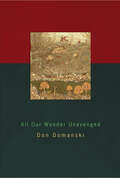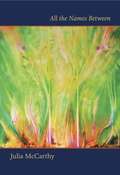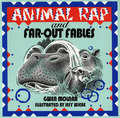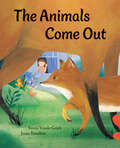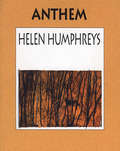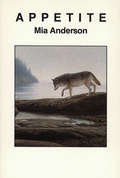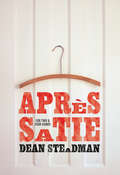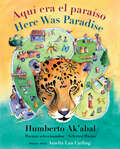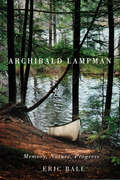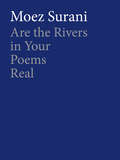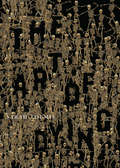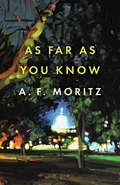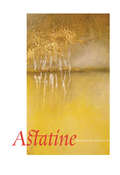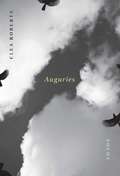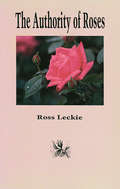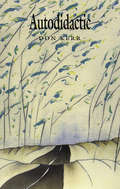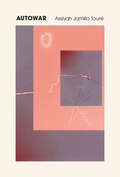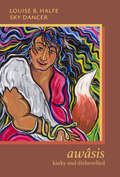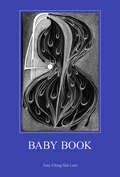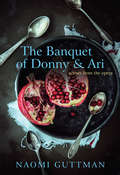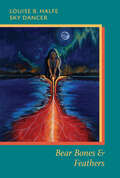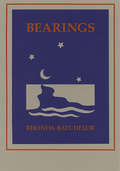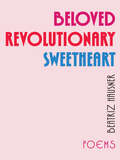- Table View
- List View
All Our Wonder Unavenged
by Don DomanskiA poet of osmosis explores the implicit relationship between matter and spirit, the interconnectedness of the universe.In his first full-length collection since 1998's Parish of the Psychic Moon, Don Domanski writes with clarity of vision. He is a poet of the holiness of subtleties, a master of mindfulness and being. His writing is a form of osmosis, spirit seeping through the details of each poem, creating a marvel of metaphysics and language distilled to purest energy. Living in the moment here is synonymous with being the moment, a transformation that is stunning to inhabit.
All the Names Between
by Julie McCarthyPoems that form an eloquent, searching contemplation of “the warp and weft of being and nonbeing.” All the Names Between is Nova Scotia poet Julia McCarthy’s meditative and crackling-with-dark-energy third collection. From her observation of “long-horned beetles... rearranging the landscape” to an apperception of “part of me /...seeded by dust / of meteors and asteroids,” McCarthy makes palpable, in richly layered imagery and with attentiveness that unfolds stillness, the “Singing Emptiness” that informs and quickens the crow’s flight, the stones’ weight, and our own being as we move in “the defined world both elegant / and maimed.” Concerned with both the inadequacy and the necessity of word to convey world, the poems move through a shifting landscape of seasons and creatures, of the remembered dead, and of scattered stones reading the Akashic field. Grounded in the experience of presence, where the external and internal meet, a crossroads of consciousness where “a language without a name / remembers us” and the poem is a votive act, All the Names Between reflects the shadow-light of being, of what is and what isn’t, the seen and the unseen, the forgotten and the remembered where every elegy has an ode at its centreevery ode has an elegy around its edges. (from “Ode with an Elegy around its Edges”) Praise for All the Names Between: “It is Julia McCarthy’s incomparable eloquence as a poet to, as an experienced photographer might, wield darkness as an ever more powerful lens to reveal the intricate beauty of the world as she finds it. And it is with this extraordinary vision, that McCarthy ushers us into her newest collection, All the Names Between, ‘where the dead gather like trees in their white coats’ and bats hover overhead, ‘lucifugal as ashes from invisible fires.’ These are poems scintillate with vision and stunningly intimate—showing us page after page the full, and exquisite measure of ‘night’s worth.’” —Clarise Foster, Editor, Contemporary Verse 2 “Here is a book of meditations for even those immune to poetry, a poetry with no comfort zones. McCarthy takes readers to a world where the marriage between solitude and nature gives birth to memorable, haunting lines, where the mystery of poetry lies just between the words. I have no doubt readers will embrace this book as their own.” —Goran Simić, author of Immigrant Blues and From Sarajevo, with Sorrow
Angel and the Bear
by Brian CharltonA pinball wizard stars in this urban romance, set where the blues meet jazz in London, Ontario's historic York Hotel.
Animal Rap and Far-Out Fables
by Gwen MolnarWhat do you do with elephants escaped from the zoo, or whales swimming loops around in your soup? Gwen Molnar answers these and other puzzling questions in a rollicking collection of readable, singable poems.
The Animals Come Out
by Susan Vande GriekDo you ever wonder what could happen if we all hid away? If we stayed in, we just might see … the animals come out! A delightful series of poems describes the many animals that emerge from the woods, the hills and the skies when we are not around. Peek out your window and watch the deer grazing under the streetlights, the rabbits hopping through our vegetable gardens, and the ducks quack quack quacking along the sidewalks. The Animals Come Out was inspired by the wildlife seen in quieted urban areas during the early days of the COVID-19 pandemic, a situation that young readers may well remember. But this book also encourages readers to be aware that, in fact, we share the outdoors with these animals all the time, and to consider the impact that we have upon them. Key Text Features illustrations Correlates to the Common Core State Standards in English Language Arts: CCSS.ELA-LITERACY.RL.1.3 Describe characters, settings, and major events in a story, using key details. CCSS.ELA-LITERACY.RL.1.4 Identify words and phrases in stories or poems that suggest feelings or appeal to the senses. CCSS.ELA-LITERACY.RL.2.4 Describe how words and phrases (e.g., regular beats, alliteration, rhymes, repeated lines) supply rhythm and meaning in a story, poem, or song.
Anthem
by Helen HumphreysWinner of the 2000 Canadian Authors Association Award for Poetry and shortlisted for the 2000 Pat Lowther Award and the 2001 Milton Acorn Memorial People’s Poetry Prize Physical and fiercely lyric, Helen Humphreys' Anthem is a litany of want. A song of poverty and of desire, of the reach forward and the relentless backward glance. With stark images and subtle, tensile strength, her poems touch that rare interval between presence and absence, echo and answer, between wall and window and sky -- that gap in which we live, the space words make.
Appetite
by Mia AndersonVerve, energy, wit, piquance and pure linguistic excitement: Mia Anderson's poetry is a whole cookbook of poetic experiences. Anderson is always ready to take big risks, and her work shows her love of life in its manyness and accident, as well as a delight in the intricate prism of language. Appetite includes the long poem sequence "The Saugeen Sonata" which won The Malahat Review's Long Poem Prize in 1988.
Après Satie: For Two and Four Hands
by Dean SteadmanA man who might be Erik Satie floats, a la Magritte, above Paris rooftops, thinking of a newly-extinct species of songbirds, "contemplating grief in the absence of song." By turns tender, wry, playful and fierce, the poems in Dean Steadman’s second collection, Apres Satie -- For Two and Four Hands, use surreal imagery, recurring characters and cyclical themes to evoke the repetitive nature of much of Satie’s music, as well as the artistic and intellectual temperament of Paris during Satie's most creative years. The prose poems in the collection borrow titles from Satie's piano compositions, and all of the poems are annotated in a manner similar to Satie's published scores, using a selection of his performance instructions (for example, "like a nightingale with a toothache"). From the affair of Satie and painter Suzanne Valadon to the glimpsed lives of a contortionist, a French cowboy, a Falling Man, and a Floating Woman in the Dada-inflected prose poems, to the musings in other poetic forms that draw us forward in time, to a present-day hospice, or back, to the gallop of a mounted huntress, Apres Satie involves us in the ongoing muddle of pain, sorrow, compassion, passion, joy and curiousness that is our human condition.
Aquí era el paraíso / Here Was Paradise: Selección de poemas de Humberto Ak’abal / Selected Poems of Humberto Ak’abal
by Humberto Ak'abalA collection of poetry by one of the greatest Indigenous poets of the Americas about the vanished world of his childhood — that of the Maya K’iche’. Aquí era el paraíso / Here Was Paradise is a selection of poems written by the great Maya poet Humberto Ak’abal. They evoke his childhood in and around the Maya K’iche’ village of Momostenango, Guatemala, and also describe his own role as a poet of the place. Ak’abal writes about children, and grandfathers, and mothers, and animals, and ghosts, and thwarted love, and fields, and rains, and poetry, and poverty, and death. The poetry was written for adults but can also be read and loved by young people, especially in this collection, beautifully illustrated by award-winning Guatemalan-American illustrator Amelia Lau Carling. Ak’abal is famous worldwide as one of the great contemporary poets in the Spanish language, and one of the greatest Indigenous poets of the Americas. Ak’abal created his poems first in K’iche’, then translated them into Spanish. Key Text Features foreword biographical information poems translation Correlates to the Common Core State Standards in English Language Arts: CCSS.ELA-LITERACY.RL.4.2 Determine a theme of a story, drama, or poem from details in the text; summarize the text. CCSS.ELA-LITERACY.RL.5.4 Determine the meaning of words and phrases as they are used in a text, including figurative language such as metaphors and similes. CCSS.ELA-LITERACY.RL.5.5 Explain how a series of chapters, scenes, or stanzas fits together to provide the overall structure of a particular story, drama, or poem. CCSS.ELA-LITERACY.RL.5.7 Analyze how visual and multimedia elements contribute to the meaning, tone, or beauty of a text (e.g., graphic novel, multimedia presentation of fiction, folktale, myth, poem). CCSS.ELA-LITERACY.RL.6.2 Determine a theme or central idea of a text and how it is conveyed through particular details; provide a summary of the text distinct from personal opinions or judgments. CCSS.ELA-LITERACY.RL.6.5 Analyze how a particular sentence, chapter, scene, or stanza fits into the overall structure of a text and contributes to the development of the theme, setting, or plot.
Archibald Lampman: Memory, Nature, Progress
by Eric BallTreasuring the past, savouring the present, and wanting to do right by the future, Archibald Lampman was a poet keenly focused on the workings of time. He was also a thinker of mystical predisposition. His goal was not to transcend time, but to find redemptive meaning within it. Archibald Lampman: Memory, Nature, Progress explores the ways in which Lampman pursued this goal in relation to the three faces of time. Memory fascinated Lampman. He relished the “alchemy” by which the dross of past experience could be left behind and the gold preserved. Nature compelled his mind and emotions, and his clear-eyed observations of both countryside and wilderness settings gave rise to a self-evolved poetics of inclusiveness. In his celebrations of nature in all its manifestations, mild or bleak, he anticipated the work of iconic Canadian painter Tom Thomson and he forecasted the environmentalism of our own time. Progress for Lampman spelled societal rectification. By forwarding the cause of social betterment, one was part of a movement larger than oneself, and this expansion, too, was redemptive. Archibald Lampman: Memory, Nature, Progress is the first book on this foundational figure in Canadian literature to appear in over twenty-five years and the first thematically focused study. Combining close analysis with biographical context, it shows how Lampman’s oeuvre was shaped by his responses to his physical surroundings and to his social-intellectual milieu, as filtered through his stubbornly independent outlook.
Are the Rivers in Your Poems Real
by Moez SuraniAmidst the dangers of figurative language, the coercion of sentimentality, and the insidious freight of abstraction, these poems embody the necessity for the critical, the communal, the real. Are the Rivers in Your Poems Real uses conceptual critiques of public discourse and experimental social cartographies, as well as lyrics of intimacy, to defy prescribed ways of being. This is an act of resistance against dangerous and domineering narratives, and the power they inscribe.
The Art of Dying (Hugh MacLennan Poetry Series #41)
by Sarah TolmieHate to tell you, but you’re going to die. / Quite soon. Me, too. / Shuck off the wisdom while it’s warm. / Death does no harm / To wisdom. Sarah Tolmie’s second collection of poems is a traditional ars moriendi, a how-to book on the practices of dying. Confronting the fear of death head-on, and describing the rituals that mitigate it, the poems in The Art of Dying take a satirical look at the ways we explain, enshrine, and, above all, evade death in contemporary culture. Some poems are personal – a parent tries to explain to a child why a grandfather is in hospital, or stages a funeral for a child’s imaginary friend – while others comment on how death figures in the news, on TV, and in social media. Some poems ask if there is any place left for poets in our rituals of memory and commemoration. A few examine the apocalyptic language of climate change. Others poke fun at the death-defying claims of posthumanism. A thoughtful and irreverent collection about serious concerns, The Art of Dying begins and ends with the fact of death, and strips away our euphemisms about it.
The Artemesia Book: Poems Selected and New
by Colleen ThibaudeauGranddaughters, asters, Medea cakes, para pom tandle, Mrs. Roker raking, Caraquet, angelic recurrence, Neruda, zupzupzup, the high bush cranberries, the Somme, a waterfall in Iceland that cries by the thousandsful, the Strawberry Shaman and the Japonica Bushelful Bountiful Lady: you would never mistake a Colleen Thibaudeau wordscape for any other. Her poems might have been written just after the imagination was invented. So lithe and playful, so naturally leaping even in elegy, they would seem like fabulous accidents if Colleen hadn't been making them, with no loss of freshness, for over forty years. There is a lifetime of poems in this book.
As Far As You Know
by A.F. MoritzFrom one of the defining poets of his generation, a new collection that plumbs the depth of beauty, history, responsibility, and love.As Far As You Know, acclaimed poet A. F. Moritz’s twentieth collection of poems, begins with two sections entitled “Terrorism” and “Poetry.” The book unfolds in six movements, yet it revolves around and agonizes over the struggle between these two catalyzing concepts, in all the forms they might take, eventually arguing they are the unavoidable conditions and quandaries of human life.Written and organized chronologically around before and after the poet’s serious illness and heart surgery in 2014, these gorgeously unguarded poems plumb and deepen the reader’s understanding of Moritz’s primary and ongoing obsessions: beauty, impermanence, history, social conscience and responsibility, and, always and most urgently, love. For all its necessary engagement with worry, sorrow, and fragility, As Far As You Know sings a final insistent chorus to what it loves: “You will live.”
Astatine
by Michael KenyonAstatine is an Italian girl, who like Dante's Beatrice, haunts the narrator of Michael Kenyon's incandescent fourth book of poetry. Named after a radioactive element whose isotopes endure half-lives of mere seconds, she is simultaneously a disappearing and abiding presence who cajoles and comforts, who questions and points, who often leaves the poet puzzled, electrified, heart-broken, and wanting more. Astatine is Kenyon's meditation on the evanescent and persevering tragedy of our lives on Earth. He takes us on an inspirational journey through time that embraces all we are born to and must too soon let go of, even as we make peace with the ever-changing fortunes of existence, even as we come upon unexpected joy.
Auguries
by Clea RobertsWhether speaking of erotic love, domestic life, spiritual wilderness, or family entanglements, the poems of Auguries, the much-anticipated second collection from Yukon poet Clea Roberts, are saturated with their northern landscape. Roberts is well versed in the distances and dynamics between tedium and ecstasy, light and dark, isolation and solitude, freeze and thaw, flow and stillness. Her poems are spare and clean, each like a single larch in an immense white plain; their exactness startling and arresting. As the Gerald Lampert Award jury citation for her celebrated first book noted, “Her images . . . are not only crisp and precise, but manage to speak about the physical conditions of this place and its emotional landscape in one and the same lyrical breath . . .” Written during a period in which Roberts both became a parent and lost a parent, the poems in Auguries lend themselves to prayer, surrender, celebration, reconciliation, meditation, and auspice. Tell me how to breathe between the painful and the beautiful, my lips, my eyelids slow with cold. (from “Cold Snap”) “Clea Roberts writes poems of clear, quiet beauty. They contain the silence of perception: alive to the world with open eye and open heart.” — Anne Michaels
The Authority of Roses
by Ross LeckieNo postmodern gimmickry, no tricks except all the old ones that every good poet must learn: these lucid, evocative poems put the reader so clearly in the picture that you taste the blackberries of your childhood, shiver at the chill of rainwater down your neck in a western forest, or rake the dust from your hair as you trudge home from the Trojan War. Ross Leckie can capture the fleeting moments when we fully enter the world and believe we belong. At this low point in our country's cultural history, when more and more writers have become topical "content providers" for the ever-gaping maw of the society of the spectacle, those few artists like Ross Leckie who carefully craft their work within the poetic tradition, and who show respect for all the needs -- aural, esthetic, and intellectual -- of the most discerning readers, are more than ever to be valued.
Autodidactic
by Don KerrShortlisted for the 1998 Saskatchewan Book Award for Poetry Don Kerr's fifth poetry collection is a verbal joyride, an exuberant celebration of a book: a celebration of mountains and plains, of growing up and of being young, of being alive in the present moment and absorbing the feel of the road through the palms of your hands on the wheel. Autodidactic represents an erotics of the everyday, a tribute to place (and movement) and to family (and friends). This is not to say that Kerr sentimentalizes the ordinary, but rather that by examining it in the bright prairie sunlight, he is able to reveal its true extraordinariness. The deep-felt humour that is in many of the poems here does not arise from gilding events with comedy, but from the poet's seeing and drawing out of events what is truly and inherently comic within them. In this book Kerr is able to demonstrate the many shades of his voice and the many facets of his craft.
Autowar
by Assiyah Jamilla TouréA visceral, vital, unblinking debut collection of poems exploring kinesthetic memory and longing, inherited violence, and the body as a geographical site. We're often told that we are given only what we can bear. For some of us our first lessons are in how much pain we're made to think we deserve—and the resulting scars are always meant to be kept secret. Assiyah Jamilla Touré's debut collection is a record of those scars—not those inflicted on us by the thousands of little wars we live in everyday, but those that come afterwards, those we inflict upon ourselves to mark the path. Each and every poem in Autowar was written on a cell phone, transcribing an urgent revisiting of old sites of pain, and also a revisiting of one young person’s power and ability—to hurt themself, or others. These poems are powerful evocations of how even our scars have worlds and lives. here in the dark, me-spacei am insatiable for my fleshi just can't get enoughof tiny after-woundsthat's me giving, still too softfor my own teeth
awâsis – kinky and dishevelled
by Louise Bernice HalfeA gender-fluid trickster character leaps from Cree stories to inhabit this racous and rebellious new work by award-winning poet Louise Bernice Halfe. There are no pronouns in Cree for gender; awâsis (which means illuminated child) reveals herself through shape-shifting, adopting different genders, exploring the English language with merriment, and sharing his journey of mishaps with humor, mystery, and spirituality. Opening with a joyful and intimate Introduction from Elder Maria Campbell, awâsis – kinky and dishevelled is a force of Indigenous resurgence, resistance, and soul-healing laughter. If you’ve read Halfe’s previous books, prepared to be surprised by this one. Raging in the dark, uncovering the painful facts wrought on her and her people’s lives by colonialism, racism, religion, and residential schools, she has walked us through raw realities with unabashed courage and intense, precise lyricism. But for her fifth book, another choice presented itself. Would she carve her way with determined ferocity into the still-powerful destructive forces of colonialism, despite Canada’s official, hollow promises to make things better? After a soul-searching Truth and Reconciliation process, the drinking water still hasn’t improved, and Louise began to wonder whether inspiration had deserted her. Then awâsis showed up—a trickster, teacher, healer, wheeler-dealer, shapeshifter, woman, man, nuisance, inspiration. A Holy Fool with their fly open, speaking Cree, awâsis came to Louise out of the ancient stories of her people, her Elders, from community input (through tears and laughter), from her own full heart and her three-dimensional dreams. Following awâsis’s lead, Louise has flipped her blanket over, revealing a joking, mischievous, unapologetic alter ego—right on time. “Louise Halfe knows, without question, how to make miyo-iskotêw, a beautiful fire with her kindling of words and moss gathered from a sacred place known only to her, to the Old Ones. These poems, sharp and crackling, are among one of the most beautiful fires I’ve ever sat beside.” —Gregory Scofield, author of Witness, I Am “Louise makes awâsis out of irreverent sacred text. The darkness enlightens. She uses humor as a scalpel and sometimes as a butcher knife, to cut away, or hack off, our hurts, our pain, our grief and our traumas. In the end we laugh and laugh and laugh.” —Harold R. Johnson, author of Peace and Good Order: The Case for Indigenous Justice in Canada “This is all about Indigenizing and reconciliation among ourselves. It’s the kind of funny, shake up, poking, smacking and farting we all need while laughing our guts out. It’s beautiful, gentle and loving.” —Maria Campbell, author of Halfbreed (from the Introduction) “There really isn’t any template for telling stories as experienced from within Indigenous minds. In her book awâsis – kinky and dishevelled, Cree poet Louise Bernice Halfe – Skydancer presents a whole new way to experience story poems. It’s kinda like she writes in English but thinks in Cree. Lovely, revealing, funny, stunning. A whole new way to write!” —Buffy Sainte-Marie
Baby Book
by Amy Ching-Yan Lam2023 Governor General's Award for Poetry Finalist"God is personal," the astrologer said. Terrifying and also personal, like a baby. Direct and humorous, Baby Book stacks story upon story to explore how beliefs are first formed. From a family vacation on a discount bus tour to a cosmogony based on cheese, these poems accumulate around principles of contingency and revelation. Amy Ching-Yan Lam describes the vivid tactility of growth and death—how everything is constantly, painfully remade—offering a vision against the stuck narratives of property and inheritance. Power is located in the senses, in wind: multiple and restless.
The Banquet of Donny and Ari
by Naomi GuttmanUnder the sugar maples of Montreal, family life is given mythic dimensions in this sweeping novella-in-verse. If Dionysus and Ariadne lived in Montreal in the late twentieth century, would he serve veal stuffed with apples and paté de fois gras? Coach nubile young singers in a performance of L’Orfeo? Would Ariadne's thread be fashioned into tapestries of furious elegy in the face of environmental catastrophe? Would their marriage survive? Amid a fictional marriage in a state of malaise and a real world on the edge of environmental disaster, Guttman lays open moments of vexation and tenderness, of grief, guilt, betrayal and love. Sounding through these moments are the harpsichord and the loom, drawing Donny and Ari, their sons Stephan and Onno, their corgie and their parrot, into the long weave of myth, art and human history.
Bear Bones & Feathers
by Louise B. HalfeIn this new edition of her powerful debut, Plains Cree writer and National Poet Laureate Louise B. Halfe – Sky Dancer reckons with personal history within cultural genocide. Employing Indigenous spirituality, black comedy, and the memories of her own childhood as healing arts, celebrated poet Louise B. Halfe – Sky Dancer finds an irrepressible source of strength and dignity in her people. Bear Bones and Feathers offers moving portraits of Halfe’s grandmother (a medicine woman whose life straddled old and new worlds), her parents (both trapped in a cycle of jealousy and abuse), and the people whose pain she witnessed on the reserve and at residential school. Originally published by Coteau Books in 1994, Bear Bones and Feathers won the Milton Acorn People's Poet Award, and was a finalist for the Spirit of Saskatchewan Award, the Pat Lowther Award, and the Gerald Lampert Award.
Bearings
by Rhonda BatchelorThe poems in Bearings are arranged in the stressful rhythm of alternation between the intense states of being in love and/or with someone or being alone. Loss refines the vision. For Rhonda Batchelor's poetry that means a gain which shows, for example, in occasional tender lyrics about experiences not governed by love and in the tang of the west coast in her poems, though setting is never the central thing. The centre is love, particularized with an art that revitalizes the ancient subject.
Beloved Revolutionary Sweetheart
by Beatriz HausnerJuxtaposing the diction of surrealism with Ovid, Callimachus, and popular music—punk and new wave—the poems in Beloved Revolutionary Sweetheart concern themselves with various aspects of Eros.From wistful romance to explicit sex, these poems are inspired by the troubadour poets of Provence and Italy, and invoke such historical figures as the Byzantine Empress Theodora and her husband, Emperor Justinian, not to mention the Countess of Dia—Beatriz—a major poet of the troubadour tradition; these are Hausner's "alter voices," expressing permutations of presence, absence, conquest, and loss.Beloved Revolutionary Sweetheart reaches back through the millenia to create an unexpected, unconventional, and contemporary exploration of one of humanity's oldest pleasures.
